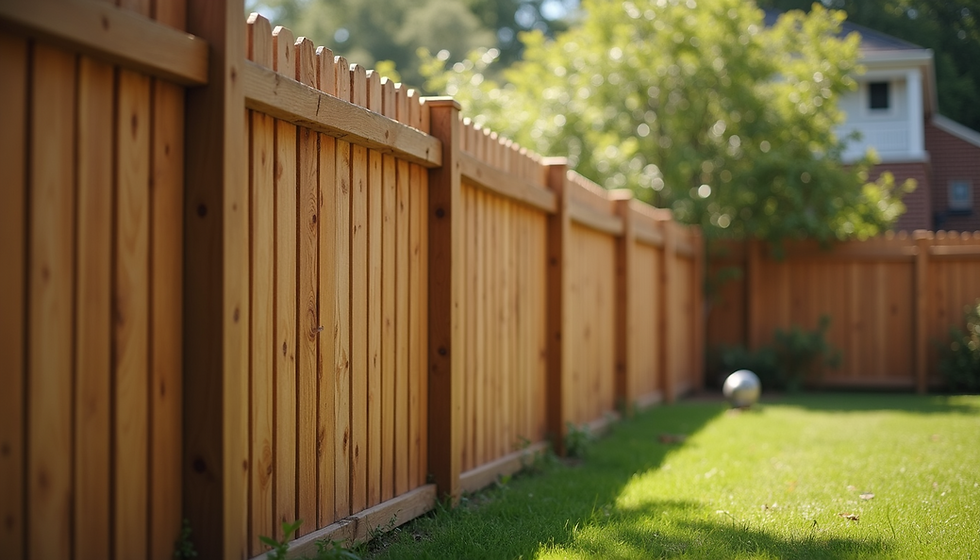Fence Installation Process: What to Expect
- skatherine95
- 11 minutes ago
- 4 min read
Installing a fence is a significant home improvement project that enhances privacy, security, and curb appeal. Whether you want to keep pets safe, define your property lines, or add a decorative touch, understanding how fences are installed can help you prepare for the process and set realistic expectations. This guide breaks down the key steps involved in fence installation, offering practical advice and tips to ensure a smooth experience.
Understanding How Fences Are Installed
Before diving into the installation, it’s important to know the basics of how fences are installed. The process typically starts with planning and measuring your property. Accurate measurements ensure you purchase the right amount of materials and avoid costly mistakes.
Next, you’ll need to check local regulations and obtain any necessary permits. Many municipalities have rules about fence height, style, and placement, so compliance is essential to avoid fines or having to remove your fence later.
Once planning is complete, the physical installation begins. This involves marking the fence line, digging post holes, setting posts in concrete, attaching rails, and finally installing the fence panels or boards. Each step requires attention to detail to ensure the fence is sturdy and looks professional.
Key Steps in Fence Installation
Planning and measuring
Checking local codes and permits
Marking the fence line
Digging post holes
Setting posts in concrete
Attaching rails and panels

Preparing Your Property for Fence Installation
Proper preparation is crucial for a successful fence installation. Start by clearing the fence line of any debris, rocks, or vegetation that could interfere with digging or post placement. If your property has uneven terrain, you may need to level the ground or plan for stepped fencing.
Use stakes and string to mark the exact location of your fence. This visual guide helps maintain a straight line and ensures your fence follows your property boundaries. It’s also a requirement to call utility companies to mark underground lines before digging to avoid accidents.
When digging post holes, the depth and width depend on the fence type and local climate. Generally, holes should be about 25%-33% the length of the post and wide enough to allow for concrete around the post. This ensures stability and durability.
Tips for Effective Preparation
Clear the fence line thoroughly
Use stakes and string for accurate marking
Contact utility companies before digging
Dig holes to the recommended depth and width

Materials and Tools Needed for Fence Installation
Having the right materials and tools on hand makes the installation process smoother and faster. The materials you need depend on the type of fence you choose—wood, vinyl, metal, or composite.
Common Materials
Fence posts (wood, metal, or vinyl)
Concrete mix for setting posts
Fence panels or individual boards
Rails (horizontal supports)
Nails, screws, or brackets
Gate hardware (if installing a gate) (Hinges, Latch)
Essential Tools
Post hole digger or auger
Level and measuring tape
Hammer or power drill
Saw (for cutting boards or panels)
String line and stakes
Shovel and wheelbarrow
Having these materials and tools ready before starting will help you avoid interruptions and keep the project on track.
The Fence Installation Process in Detail
Now that you have prepared your property and gathered materials, it’s time to install the fence. The fence installation process involves several detailed steps:
Set the Posts
Dig holes at the marked locations. Place the posts in the holes and use a level to ensure they are plum. Pour concrete around the posts and hard pack it to make sure its nice and tight.
Attach the Rails
Once the posts are secure, attach horizontal rails between them. These rails provide support for the fence panels or boards.
Install Fence Panels or Boards
Attach the fence panels or individual boards to the rails using ring shank galvanized nails or screws. Make sure each panel is level and evenly spaced.
Add Gates and Hardware
If your fence includes a gate, install it last. Attach hinges and latches according to the manufacturer’s instructions.
Finishing Touches
Inspect the fence for any loose nails or screws. Apply paint or stain if desired to protect the wood and enhance appearance.
Pro Tips for a Successful Installation
Work with a partner to hold posts and panels steady
Double-check measurements before cutting materials
Use treated wood or weather-resistant materials for longevity
Follow safety guidelines when using power tools
Maintaining Your Fence After Installation
Proper maintenance extends the life of your fence and keeps it looking great. Regularly inspect your fence for damage such as loose boards, rust, or rot. Clean the fence annually to remove dirt and mildew.
For wooden fences, apply a fresh coat of stain or paint every few years to protect against weather damage. Metal fences may require rust treatment and repainting. Vinyl fences are low maintenance but should be washed occasionally.
Maintenance Checklist
Inspect for damage every 6 months
Clean fence surfaces annually
Reapply paint or stain as needed
Tighten loose hardware promptly
Taking these steps will ensure your fence remains a valuable and attractive part of your property for years to come.
Installing a fence is a rewarding project that adds value and functionality to your home. By understanding how fences are installed and following the steps outlined here, you can achieve a professional-looking result that meets your needs. Whether you choose wood, vinyl, or metal, careful planning, preparation, and maintenance are key to a successful fence installation.





Comments